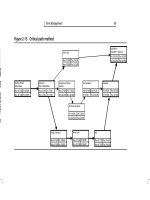Preparing for the GED - All about the GED
Bạn đang xem bản rút gọn của tài liệu. Xem và tải ngay bản đầy đủ của tài liệu tại đây (116.88 KB, 8 trang )
Edward dropped out of high school at 16 when his mother became ill and could no longer work or take care of
Edward and his younger brother. He began working full time and never finished high school.
Rajesh came to America with the equivalent of a tenth-grade education from his native country. He dreamed
of becoming a computer programmer but had to work full time. He often worked extra shifts to help make ends
meet.
Marie was a certified nurse in her native Caribbean country. But when she immigrated, she found out her nurs-
ing certification was not valid in the United States. She could not apply to a U.S. nursing program without a
high school diploma.
T
oday, after taking the GED and earning their high school diplomas, Edward, Rajesh, and Marie—
like thousands of others who take the GED each year—are able to pursue the education and careers of
their dreams. For more than half a century, the GED diploma has given millions of people the opportu-
nity to find better employment, enroll in colleges and training programs, improve their standard of living, and feel
better about themselves and their futures.
3
CHAPTER
1
All about
the GED
PLANNING TO take the GED? Here’s what you need to know to
get started. This chapter covers the basic information about these
important exams. You will learn how the tests are structured, how to
register, and how the tests are scored.
What the Tests Are About
The General Educational Development (GED) exami-
nation is a series of tests covering the broad range of
knowledge and skills students are expected to master in
high school. They are tests for people who wish to earn
a high school diploma but who have been unable to
graduate in the traditional manner. Passing the GED cer-
tifies that you have a high school level education and
entitles you to a GED diploma, the equivalent of a high
school diploma. For hundreds of thousands of people
each year, the GED is an important stepping stone to a
better job and continued education.
Did You Know?
The GED was originally developed for veterans
returning from World War II to help them
complete their educations and earn their high
school credentials. The first test was adminis-
tered more than 60 years ago, in 1942. Since
then, an estimated 15.2 million people have
taken the GED.
The GED is jointly administered by the General Edu-
cation Development Testing Service, a program of the
American Council on Education (ACE) Center for Adult
Learning and Education Credentials, and the education
department of each participating state or province. The
GED exams are actually a battery of five tests that meas-
ure knowledge in five content and skills areas: writing,
reading comprehension (understanding literature), social
studies, mathematics, and science.
GED Components
The GED examinations are actually a battery of
five separate tests:
➧
Language Arts, Writing (Parts I and II)
➧
Social Studies
➧
Science
➧
Language Arts, Reading
➧
Mathematics (Parts I and II)
The complete battery of GED exams takes a total of
seven hours and five minutes. The level of difficulty is set
so that only two-thirds of traditional high school seniors
will pass. On average, at least two-thirds of adults who
take all five exams earn their diploma, and many states
report even higher pass rates. In Utah, for example,
nearly three-quarters (74%) of GED test takers passed
the exam last year. And Iowa boasts a remarkable 95%
pass rate for 2001.
In many testing centers, you can take the GED one test
at a time until you complete all five exams. In others,
you must take the entire battery of tests in one or two
sessions.
The questions on the GED are all multiple choice with
two important exceptions. Part II of the Language Arts,
Writing Test requires you to write an essay, and about
25% of math questions are “alternate format” questions
that may include short written responses. You will learn
details about each exam, including the specific material
covered and the kind of questions to expect, throughout
the rest of this book.
GED Fact Box
According to the American Council on Educa-
tion, which oversees the GED Testing Service:
➧
Over 860,000 adults around the world take
the GED tests each year.
➧
Test takers who pass the GED outperform
40% of high school seniors on the exam.
➧
Approximately 14% of the high school
diplomas distributed each year in the
United States are issued to adults who
pass the GED.
➧
Over 95% of U.S. colleges accept students
with GED credentials, and over 95% of
U.S. employers offer GED graduates the
same hiring, compensation, and promotion
opportunities as employees with a tradi-
tional high school diploma.
➧
Approximately 1 in 20 first-year college
students are GED graduates.
–
ALL ABOUT THE GED
–
4
Who Takes the GED—and Why
The 860,000 people who take the GED each year are a
very diverse group who come from a rich variety of back-
grounds. As different as their situations and experiences
may be, their main reasons for taking the GED are the
same. Passing the GED:
■
enables them to apply to colleges and universities
■
allows them to apply for jobs or promotions that
require a high school diploma
■
demonstrates to others the importance of
education
■
is a significant accomplishment that improves
self-esteem
GED candidates range in age from 16 to over 60. The
ACE’s publication Who Took the GED? reports that
slightly over half the GED candidates in 2001 were
between the ages of 20 and 39, with an average age of
25.2 years. Two-thirds of the test takers reported com-
pleting tenth grade; one-third had completed their jun-
ior or senior years. Nearly two-thirds of the test takers
reported plans to pursue higher education after earning
their GED diploma.
More GEDs Than Ever
2001 was a record year for the GED—over one
million people took all or part of the exams. The
record number was partly due to the new GED
2002 test series. Test takers had to complete
the old GED by December 31, 2001, or else
begin all over with the new exam. Of the
979,829 adults who took all five exams,
669,403 (68%) earned their high school equiv-
alency diplomas.
GED Eligibility Requirements
GED candidates must first meet certain eligibility
requirements set by the ACE and participating states and
territories. You are eligible to take the GED if you meet
the following conditions:
1. You are not enrolled in high school AND
2. You have not graduated from high school AND
3. You are at least 16 years of age AND
4. You meet the requirements of your state,
province, or territory regarding age, residency, and
the length of time since leaving school. Arkansas,
for example, requires that you be a “legal resident”
of the state, which means that you must spend
most of your time in Arkansas, pay property taxes,
and possess a valid Arkansas driver’s license or
state-issued identification card. Kentucky’s eligi-
bility requirements vary depending upon the can-
didate’s age. Be sure to check with your state
department of education or your local testing cen-
ter for specific eligibility requirements.
Testing Centers and Registration
There are approximately 3,400 GED testing centers
around the world. These centers are typically operated by
local school boards, community colleges, and/or centers
for adult education. Test takers outside the United States,
Canada, or their territories may be able to take the GED
at a Thomson Prometric facility.
Because test centers are run locally, registration pro-
cedures, fees, and testing times vary. You need to contact
the center where you would like to take the tests to find
specific registration, fee, and test time information.
If you live inside the United States, Canada, or their
territories, you can find the testing center nearest you by:
1. Calling 1-800-62-MY-GED OR
2. Checking in the blue pages of your local tele-
phone book (look for “GED Testing” under the
state department of education listing) OR
3. Going to www.acenet.edu/clll/ged/area-contacts-
TT.cfm. From there, select your specific area to
find out how to contact your local testing center.
International Testing
If you live outside the United States, Canada, or their
territories, you can still take the GED through one of
Thomson Prometric’s testing centers. Thomson Promet-
ric, in partnership with the ACE, offers a computer-based
GED and a high school diploma through the state of
–
ALL ABOUT THE GED
–
5
Maine. If you reside outside the United States, Canada,
or their territories and wish to take the online exam, you
must be at least 17 years old.
For more information on international testing for
the GED, contact 866-776-6387 or Thomson Prometric,
1000 Lancaster Street, Suite 200, Baltimore, MD 21202.
Ask for the Regional Registration Center in your
country or province. Or visit their website at www.
prometric.com.
Thomson Prometric has testing centers available in
the following regions:
■
Australia/New Zealand
■
China
■
Europe
■
India
■
Indonesia
■
Japan
■
Korea
■
Latin America/Caribbean
■
Middle East/North Africa
■
Pakistan
■
Southeast Asia
■
Sub-Sahara/Africa
■
Taiwan
■
Thailand
Spanish and French Versions of
the GED
In addition to the standard English version of the GED,
there are also Spanish and French versions, initially devel-
oped for Puerto Rico and Canada, respectively. These tests
are now authorized for use throughout the United States
but may not be available in all areas and are not available
at international testing centers (international GED can-
didates must take the English version). A new version of
both the Spanish and French GEDs went into effect on
January 1, 2004. Any partial scores from individual Span-
ish or French exams taken prior to December 31, 2003,
are invalid, and candidates must take the complete battery
of new exams.
The Spanish GED
The structure and content of the Spanish GED is essen-
tially the same as the English GED, with the important
exception that the examples and test questions are based
on Spanish language and culture. In the Language Arts,
Reading Test, all excerpts are from Spanish-language
writers with an emphasis on writers from the Caribbean
and Central and South America. In the Language Arts,
Writing Exam, grammar questions focus on issues spe-
cific to the Spanish language, such as gender agreement
and multiple-object pronouns. The essay is scored by
readers whose first language is Spanish or who are sec-
ondary or college-level Spanish instructors.
The French GED
The French GED also follows the English GED in format
and structure. Like the Spanish GED, it draws its ques-
tions and context from French language and culture.
Most measurement questions use the metric system.
Essays on the French exam are scored by readers whose
first language is French or who have taught French at the
secondary or college level.
Special Accommodations
Special testing accommodations are available for GED
candidates with documented disabilities that may affect
their ability to pass the GED. These accommodations
include:
■
testing in English-language Braille
■
testing by audiocassette
■
large-print test editions
■
extended time
■
frequent, supervised breaks
■
use of a calculator or scribe
■
private testing rooms
Dictionaries and spell checkers are not permitted, nor is
having someone read the questions aloud to the candidate.
If you will need special accommodations to take the
GED, request the appropriate form from your local test-
ing center:
■
Form L-15 for learning disabilities and attention
deficit/hyperactivity disorder
■
Form SA-001 for emotional and physical
disabilities
–
ALL ABOUT THE GED
–
6
Once you have completed the form and provided the
necessary documentation, return the form to your GED
testing center. Be sure to request and complete this form
well in advance of your test date to allow sufficient time
for processing.
GED Testing Fees
Fees for the GED vary widely. In some states, you can
take the GED exams at no charge; in others, all testing
centers charge the same fee (usually between $20–$80);
and in others, individual testing centers determine their
own fees (also usually between $20–$80). In Pennsylva-
nia, for example, the fee varies from $25–$55, depending
upon the location of the center. In Georgia, the fee at any
testing center is $55.
When the Test Are Offered
Each test center determines when and how often it will
offer the GED exams. Some centers may offer the tests
only two or three times a year; others offer them much
more frequently. The Paterson Adult and Continuing
Education Center in Paterson, NJ, for example, offers the
tests two or three times a month. The Aurora Public
High School System in Aurora, CO, on the other hand,
offers the tests every Thursday and two Saturdays each
month. Contact your local testing center to see when the
tests will be offered. If the dates and times are inconven-
ient, check other centers nearby. Their offerings may bet-
ter fit your schedule.
How the Tests Are Scored
Each of the five GED tests is scored separately on a stan-
dard scale of 200 to 800 points. Each correct answer is
worth one point, but because the individual tests have
different numbers of questions, the score for each test is
converted to this 200–800 standard. This allows the
scores on all five tests to be compared. The Language
Arts, Writing Test score is a statistical combination of the
scores for the multiple-choice questions and the essay,
but a high score on Part I is no longer enough to pass the
exam. Since 2002, candidates must pass both parts of the
test in order to pass the Language Arts, Writing Exam.
The GED score reflects an estimate of your skills and
knowledge in each content area as compared to recent
high school graduates. Your score will be reported in two
ways: a number from 200–800 and a percentage. The
percentage indicates how your score compares with the
performance of graduating high school students. If your
percentile rank is 85, for example, that means you have
scored better than 85% of graduating high school sen-
iors. Here’s a more detailed example:
GED TESTS SCORE
Language Arts, Writing 606
Social Studies 688
Science 490
Language Arts, Reading 621
Mathematics 552
Average Overall Score 591
Percentile Rank 81%
What Is a Passing Score?
The minimum score required to pass the GED and earn
the GED diploma is set by individual states, provinces,
and territories. The passing score is usually a combina-
tion of both a minimum score per test and a minimum
average score overall. Most testing jurisdictions use the
passing score set by the GED Testing Service:
■
a minimum score of 410 on each test
■
a minimum average score of 450 overall
If you answer approximately 60–65% of the questions
correctly, you should receive a standard score of about
410 points per exam.
–
ALL ABOUT THE GED
–
7









